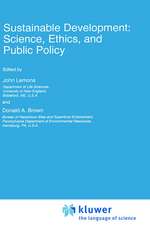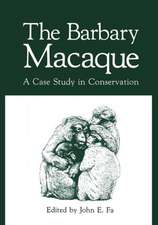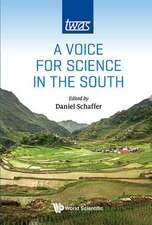Conserving Biodiversity in Arid Regions: Best Practices in Developing Nations
Editat de J. Lemons, Reginald Victor, Daniel Schafferen Limba Engleză Hardback – 31 iul 2003
| Toate formatele și edițiile | Preț | Express |
|---|---|---|
| Paperback (1) | 954.93 lei 6-8 săpt. | |
| Springer Us – noi 2012 | 954.93 lei 6-8 săpt. | |
| Hardback (1) | 959.36 lei 6-8 săpt. | |
| Springer Us – 31 iul 2003 | 959.36 lei 6-8 săpt. |
Preț: 959.36 lei
Preț vechi: 1169.95 lei
-18% Nou
Puncte Express: 1439
Preț estimativ în valută:
183.57€ • 200.03$ • 154.69£
183.57€ • 200.03$ • 154.69£
Carte tipărită la comandă
Livrare economică 23 aprilie-07 mai
Preluare comenzi: 021 569.72.76
Specificații
ISBN-13: 9781402074837
ISBN-10: 1402074832
Pagini: 524
Ilustrații: XV, 497 p.
Dimensiuni: 155 x 235 x 34 mm
Greutate: 0.84 kg
Ediția:2003
Editura: Springer Us
Colecția Springer
Locul publicării:New York, NY, United States
ISBN-10: 1402074832
Pagini: 524
Ilustrații: XV, 497 p.
Dimensiuni: 155 x 235 x 34 mm
Greutate: 0.84 kg
Ediția:2003
Editura: Springer Us
Colecția Springer
Locul publicării:New York, NY, United States
Public țintă
ResearchCuprins
1 Case Studies on Conserving and Sustainably Using Biodiversity in Arid and Semiarid Regions of Southern Nations.- Africa.- 2 The Domestication of Indigenous Trees as the Basis of Sustainable Land Use in Africa.- 3 Conservation Farming with Biodiversity in South Africa: A Preliminary Evaluation of Ecosystem Goods and Services in the Bokkeveld Plateau.- 4 Strategies for In Situ Conservation of Crop Genetic Resources in Dryland Areas of Africa.- 5 A Participatory Approach for Conservation of Forest Genetic Resources.- 6 Agriculture and Biodiversity Conservation in Africa Through Indigenous Knowledge.- 7 Participation of Local Communities in the Management of Wetlands in Magadi Area, Kenya.- 8 The Value of Local and Indigenous Knowledge for the Development of Information Systems for Conservation Management.- 9 Best Practices in the World’s Oldest Desert.- 10 A Commentary on Strategies and Incentives to Improve Biodiversity in Arid and Semi-Arid Zones.- Asia.- 11 Conservation and Sustainable Use of Biodiversity in the Trans-Altai Gobi Desert of Mongolia.- 12 Ecological Assessment of Degradation Processes in the Mongolian Part of Baikal Basin.- 13 Plant Diversity and Succession of Artificial Vegetation Types and Environment in an Arid Desert Region of China.- 14 Plant Production and Diversity at Desertification Stages in Horqin Sand Grassland Region, China.- 15 Aquatic Biodiversity in Arid and Semi-Arid Zones of Asia and Water Management.- 16 Traditional Management of Biodiversity in India’s Cold Desert.- 17 Conserving Biodiversity in Arid Regions: Experiences with Protected Areas in India.- 18 Co-Management Processes to Maintain Livestock Mobility and Biodiversity in Alpine Rangelands of the Tibetan Plateau.- Latin America and the Caribbean.- 19 Theoretical Models forRegeneration of Medicinal Plants and Their Application in Sustainable Wild-Harvesting.- 20 Plants of Northeastern Brazil: A Programme in Sustainable Use of Plant Resources.- 21 Choice of Species for Recovering a Degraded Mining Area in the Semiarid Zone of Brasil.- 22 Use of Creeping Fog Water as a Non-Traditional Water Resource in Chile.- 23 Genetic Diversity and Management Implications for Vicuña Populations in Peru.- 24 Sustainable Use of the Vicuña: A Critical Analysis and the MACS Project.- 25 Sustainable Use of Andean Wildlife and Local Development of Rural Communities in Dry Areas of Latin America: A Commentary.- 26 Conflicts and Dilemmas Between Poverty and Biodiversity in the Semi-Arid Seridó of Northeast Brazil.- 27 Latin American Plant Sciences Network: A Program for the Development of Plant Sciences and Conservation of Biodiversity in Latin America.- 28 The Brazilian Biodiversity Virtual Institute.- 29 Capacity Building to Sustainably Use Biodiversity in Dryland Regions of Latin America and the Caribbean.- North Africa and the Middle East.- 30 The Importance of Native Trees in Sustaining Biodiversity in Arid Lands.- 31 Site Selection Criteria for Mangrove Afforestation Projects in Oman.- 32 The Globally Threatened Corncrake Crex crex (Egypt).- 33 Conservation of Fig (Ficus Carica L.) and Pomegranate (Punica Granatum L.) Varieties in Tunisia.- 34 A Sociological Perspective on In Situ Conservation of On-Farm Crop Genetic Diversity in Morocco.- 35 Biodiversity Conservation and Sustainable Development: A Case Study of Oman’s National Biodiversity Strategy and Action Plan.- Regionwide.- 36 Achieving Institutional Cooperation for Implementation of Sustainable Development Plans and Strategies.













